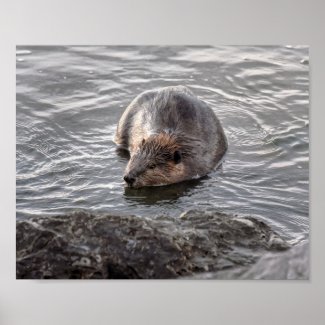I expected to see pelicans, cormorants, gulls and dolphins at the beach on Dauphin Island, Alabama, but seeing a beaver swimming along the rocks and edge of the beach was certainly a surprise. This beaver seemed to be exploring. I don’t think there was anything for him to eat along the beach, and ingesting salt water isn’t healthy for a beaver. Maybe he was lost. It was near sunset, a full moon, choppy waves, a lot of bird activity and even a dolphin cruising around. The next day, I saw a beaver swimming past a sunning alligator in the lake in the Audubon Bird Sanctuary. That doesn’t seem very safe, either.
In articles I’ve read since, some biologists say beavers travel in saltwater to move from one environment to another. Other scientists said they are moving to brackish environments due to decreasing habitat. In these habitats near the ocean, the beavers have built their lodges to accommodate the tides. Biologists have found beavers suffering from saltwater poisoning, however, from consuming too much saltwater while while chewing trees and plants for lodge construction and while eating.
Beavers are large, semiaquatic rodents of the temperate Northern Hemisphere. This was a North American beaver (Castor canadensis). Beavers are the second-largest living rodents after the capybaras. Their usual habitat is freshwater, such as rivers, streams, lakes and ponds. They are herbivorous and consume tree bark, aquatic plants, grasses and sedges.
Dauphin Island is a barrier island at the mouth of Mobile Bay in the Gulf of Mexico. It’s called the Sunset Capital of Alabama and is home to the Audubon Bird Sanctuary and other refuges, to 19th century Fort Gaines, Dauphin Island Sea Lab, The Estuarium public aquarium, many white sand beaches, historic sites and points of interest. Dauphin Island is considered one of the top four locations in North America for viewing spring bird migrations. The Sanctuary consists of 137 acres of maritime forest, marshes, and dunes, including a lake, a swamp, and a beach. The three-mile trail system within the Sanctuary is a National Recreational Trail. The refuge is at the Eastern end of Dauphin Island, a 14 mile-long barrier island south of the Alabama mainland Gulf Coast.

In the top photograph, a beaver swims in Galliard Lake in the Audubon Bird Sanctuary on Dauphin Island, Alabama. On the right is a Great Blue Heron. The beaver swam past an alligator basking in the sunshine.

In the top photograph, a beaver swims in Galliard Lake in the Audubon Bird Sanctuary on Dauphin Island, Alabama. On the right is a Great Blue Heron. The beaver swam past an alligator basking in the sunshine.
About the Dauphin Island Audubon Bird Sanctuary.















